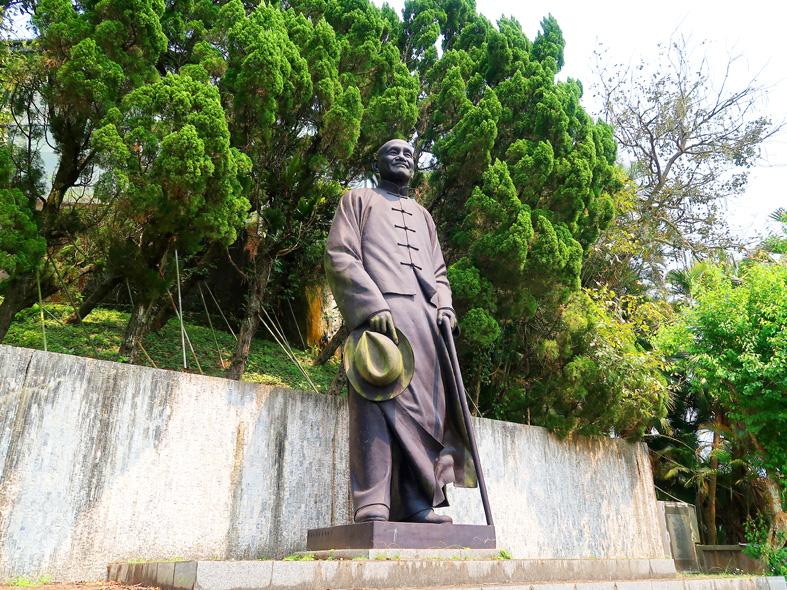As of Wednesday, 403 authoritarian symbols had been removed or were scheduled for removal, while 537 were still in place, Transitional Justice Commission data showed yesterday, although the Ministry of National Defense, Ministry of Education and the Veterans Affairs Council had yet to report on such symbols under their jurisdiction.
More than 40 statues or other authoritarian symbols have been excised since August last year, after the central government removed an additional 11 and local governments eliminated 32, data showed.
However, the status of the 410 items managed by the ministries of defense and education is unclear.

Photo: Chen Yu-fu, Taipei Times
Of the 537 symbols still remaining in public areas, 84 are managed by the central government and 453 by local governments, although the figure does not include those managed by the three agencies.
Kaohsiung, as well as Miaoli, Yunlin, Hualien and Penghu counties, also had yet to respond to the commission.
The Presidential Office manages four statues, all of which are at former president Chiang Ching-kuo’s (蔣經國) mausoleum in Taoyuan’s Dasi District (大溪), and have not been removed, the data showed.
The Legislative Yuan has agreed to remove the bronze statue of former president Chiang Kai-shek (蔣介石) from its service center in Taichung, but as it is located on the grounds of the former Taiwan Provincial Consultative Council, officials are deliberating whether it should be considered a cultural asset, the commission said.
The Examination Yuan is also to change the names of three locations and remove two bronze statues under its jurisdiction, it added.
Of the 14 authoritarian symbols managed by the Ministry of the Interior, nine statues are to be removed and five names changed, including Zhongzheng Hall (中正堂) on the Pratas Islands (Dongsha Islands, 東沙群島), which has already been renamed, it said.
Two statues managed by the Ministry of Economic Affairs have yet to be removed, including a large bronze statue of Chiang Kai-shek in a long robe and magua at Taoyuan’s Shihmen Reservoir (石門水庫), which is inside a paid scenic area, the report said.
Meanwhile, the Veterans Affairs Council has moved five of the 61 authoritarian symbols under its jurisdiction to storage or the National Property Administration, and is awaiting approval for them to be removed permanently, the commission said.
A bronze statue of Chiang Kai-shek remains at the National Palace Museum in Taipei, as do two administered by the Council of Agriculture, it added.
The Ministry of Culture manages 13 statues, one of which is at the Green Island White Terror Memorial Park, while the rest are at the Chiang Kai-shek Memorial Hall in Taipei, it said, adding that 12 are still in place.
The commission said that it this month plans to submit recommendations for dealing with the memorial hall.
In addition to the Veterans Affairs Council’s efforts, Taipei has agreed to remove 40 authoritarian symbols, while all three of Chiayi City’s bronze statues have been eliminated, a commissioner told reporters, vowing to continue negotiating with central government agencies and local governments to remove those remaining.

A strong continental cold air mass is to bring pollutants to Taiwan from tomorrow, the Ministry of Environment said today, as it issued an “orange” air quality alert for most of the country. All of Taiwan except for Hualien and Taitung counties is to be under an “orange” air quality alert tomorrow, indicating air quality that is unhealthy for sensitive groups. In China, areas from Shandong to Shanghai have been enveloped in haze since Saturday, the ministry said in a news release. Yesterday, hourly concentrations of PM2.5 in these areas ranged from 65 to 160 micrograms per cubic meter (mg/m³), and pollutants were

Taiwan’s armed forces have established response protocols for a wide range of sudden contingencies, including the “Wan Chun Plan” to protect the head of state, the Ministry of Defense (MND) said today. After US President Donald Trump on Saturday launched a series of airstrikes in Venezuela and kidnapped Venezuelan President Nicolas Maduro, concerns have been raised as to whether China would launch a similar “decapitation strike” on Taiwan. The armed forces regularly coordinate with relevant agencies and practice drills to ensure preparedness for a wide range of scenarios, Vice Minister of National Defense Hsu Szu-chien (徐斯儉) told reporters before a

EVA Airways on Saturday said that it had suspended a pilot and opened an investigation after he allegedly lost his temper and punched the first officer several times as their plane was taxiing before takeoff at Los Angeles International Airport. According to a report published on Thursday by The Reporter, the incident occurred after the flight’s Malaysian first officer tried to warn the Taiwanese pilot, surnamed Wen (文), that he was taxiing faster than the speed limit of 30 knots (55.6kph). After alerting the pilot several times without response, the first officer manually applied the brakes in accordance with standard operating

NOT AN OPENING: Trump’s violation of international law does not affect China’s consideration in attacking Taiwan; Beijing lacks capability, not precedent, an official said Taiwanese officials see the US’ capture of the president of Venezuela as a powerful deterrent to Beijing’s aggression and a timely reminder of the US’ ability to defeat militaries equipped with Chinese-made weapons. The strikes that toppled Venezuelan President Nicolas Maduro signaled to authoritarian leaders, including Chinese President Xi Jinping (習近平), US President Donald Trump’s willingness to use military might for international affairs core to US interests, one senior official in Taipei’s security circle said. That reassured Taiwan, the person said. Taipei has also dismissed the idea that Trump’s apparent violation of international law could embolden Beijing, said the official, who was not